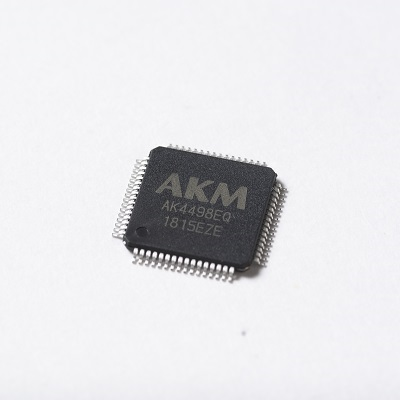Providing ICs for the Heart of People around the World
2020 年 7 月
幕后花絮 #02
The Inside Story
Insider's guide to the development of AKM Audio IC
- Past and Future -
幕后花絮
AKM's approach to audio ICs
AKM has been working on technological development while listening to the voices of the market and has achieved productization. We would like to let every audio user know AKM's audio ICs and introduce AKM's current and future efforts to develop audio ICs.
This text is current as of July 2020.
Please check akm.com for the latest information on product sales status.
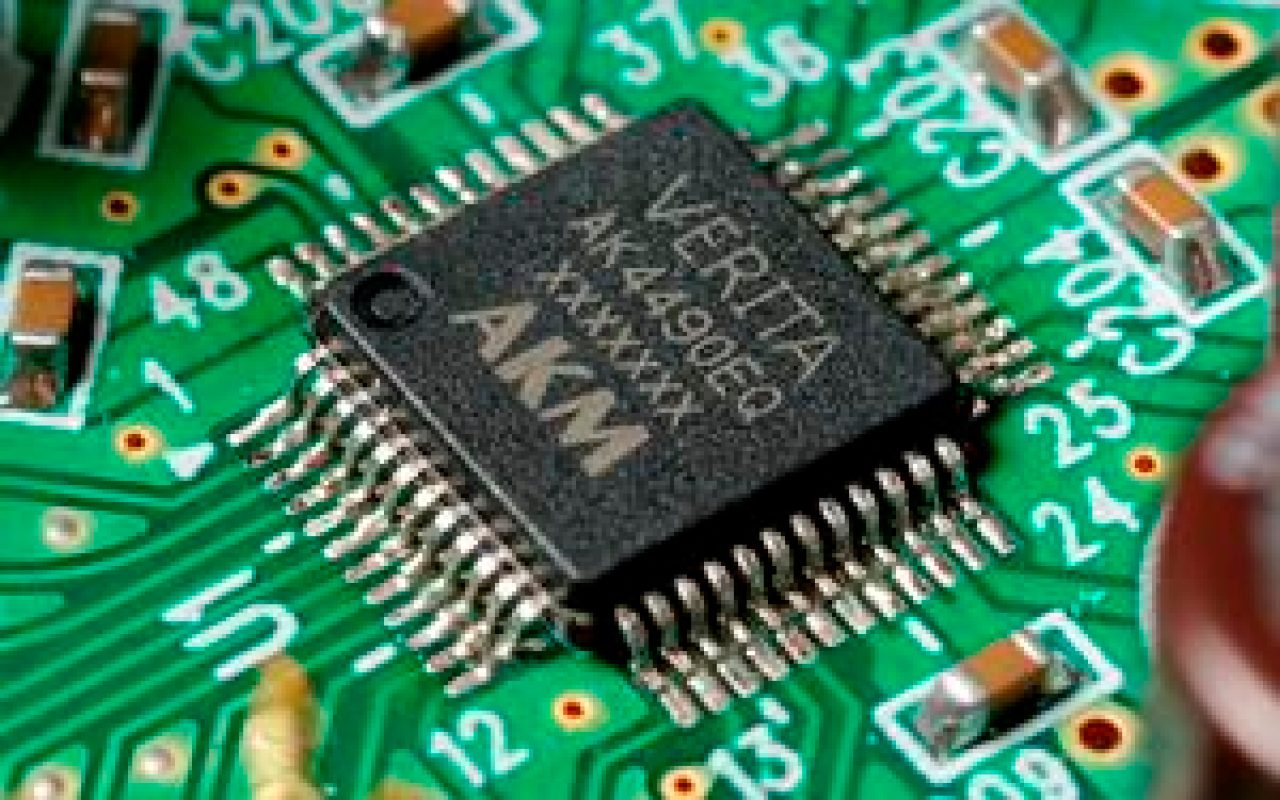 VELVET SOUND was born in 2014 with the launch of the 3rd generation flagship DAC, VERITA AK4490EQ.
VELVET SOUND was born in 2014 with the launch of the 3rd generation flagship DAC, VERITA AK4490EQ.
Table of contents
1. 33 years of experience in the audio market
2. Approach as a leading company in Audio ICs
2 - 1. Pursuing low group delay for professional audio market
2 - 2. Pursuing low delay for car infotainment market
2 - 3. Proposal of advanced high-rate format aimed at high sound quality
3. Wide range of lineup for pure audio + portable, car, professional audio and distribution
4. AKM's audio brand "VELVET SOUND"
Reference and Author’s profile
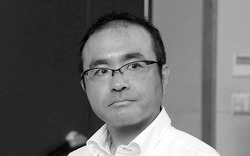 Mr. Aniya (AKM)
Mr. Aniya (AKM)
1. 33 years of experience in the audio market
This year is 33 years since AKM began supplying audio ICs to the market. Many audio ICs have been delivered to the world based on ΔΣ modulation technology. Since 2000, while improving IC performance and sound quality, we have been providing ICs with high PCM / DSD rates and PCM 32-bit high resolution to the market ahead of other companies, and are promoting product development for the next generation of high-resolution sound.
Regarding A/Dconverter (ADC), it has been adopted by many customers around the world, mainly for professional equipment, and we have received the word "AKM for ADC". D/Aconverter (DAC) in recent years, we are proud that the popularity of DAC has also improved as that is increasingly being used by customers for consumer and professional equipment.
 This is the VELVET SOUND logo, which debuted in 2014.
This is the VELVET SOUND logo, which debuted in 2014.
2 . Approach as a leading company in Audio ICs
We have received a lot of feedback from customers who have used AKM products, which will lead to the next product development. We constantly strive to incorporate this feedback as a new feature of next product development. As an example, we would like to discuss the low group delay and high rate format in ADC / DAC
2 - 1. Pursuing low group delay for professional audio market
The system for monitoring feedback to performers in concert or recording environments is generally known as shown in Figure 1. As you can see, there are two paths: one to capture the vocal / instrumental sound and feed it back to the monitor speakers, and one to record it into memory. In both cases, an ADC is required.
In addition, there is a signal path that converts a signal digitally processed by a digital signal processor (DSP) into an analog signal by DAC on the monitor speaker.
If a vocal instrument is fed back to the monitor speaker, the vocalist will not be able to make the correct sound because an echo - like condition will occur if its delay time is several tens of milliseconds. Therefore, low group delay processing is required.
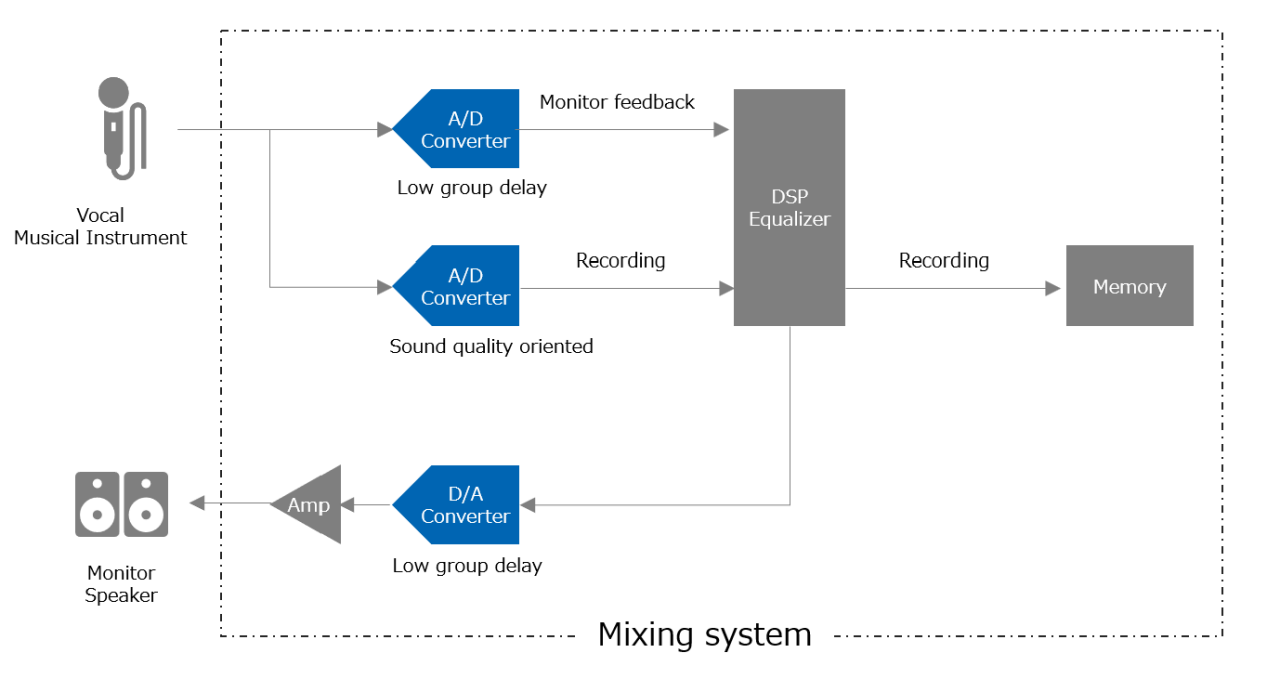 Figure1. Schematic diagram of monitor feedback & recording in concert system.
Figure1. Schematic diagram of monitor feedback & recording in concert system.
For example, when the sampling frequency (fs) is 48kHz, the longest and shortest group delay for the digital filter AKM’s ADC / DAC are compared as in Table 1. The difference is approximately 0.8 milliseconds.
As mentioned previously, a delay of several tens of milliseconds affects the vocals, so in practice system design takes as short a few milliseconds or less as possible. Concerts and recording systems require a lot of computation times because DSP carries out complex signal-processing. The reduced group delay of ADC / DAC is 0.8 milliseconds, allowing DSP to take longer.
Thus, reducing the group delay of ADC / DAC at the analogue front end greatly contributes to securing the operation time of DSP. DSP that utilizes the secured arithmetic time for other signal processing or has low arithmetic processing power.
DSP alternatives for systems such as (= inexpensive DSPs) are widely used.
Table 1. Digital Filter Group Delay Comparison when fs = 48kHz Unit [ms]
| Sharp Roll-off | Short Delay Slow Roll-off | |
|---|---|---|
| ADC | 0.4 | 0.1 |
| DAC | 0.6 | 0.1 |
| Total | 1.0 | 0.2 |
In the feedback system, DAC's digital filters are keyed by their low group delay, but in DAC's primary application for consumer audio equipment, digital filters are a sound preference.
Also, Digital filters can be fixed or variable, depending on the sound preferences of manufacturers and product specifications. Although not detailed in this article, AKM offers six digital filters in a unique design approach to broaden the sound options for creators.
On the other hand, delay is not a problem in the path of professional audio equipment that does not require a feedback system. However, in that case, a digital filter that emphasizes recording quality is required. Especially, the flatness of frequency characteristics in the audio band and the amount of out-of-band attenuation are particularly important.
Therefore, different digital filters are required for ADC used in the same system, depending on the application. For these reasons, AKM's ADC and DAC offers several digital filters. Figure 2 shows a lineup of impulse responses and group delays for ADC and DAC digital filters.
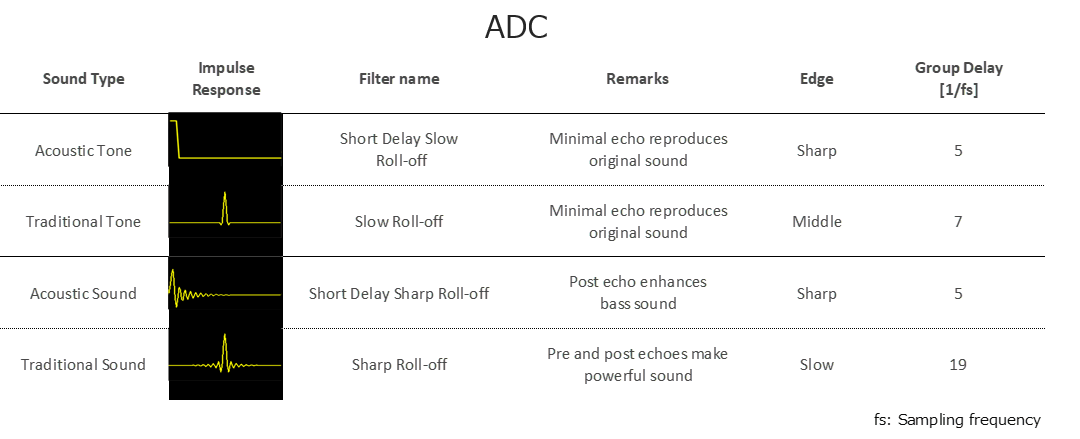 Figure 2. Digital filter (ADC)
Figure 2. Digital filter (ADC)
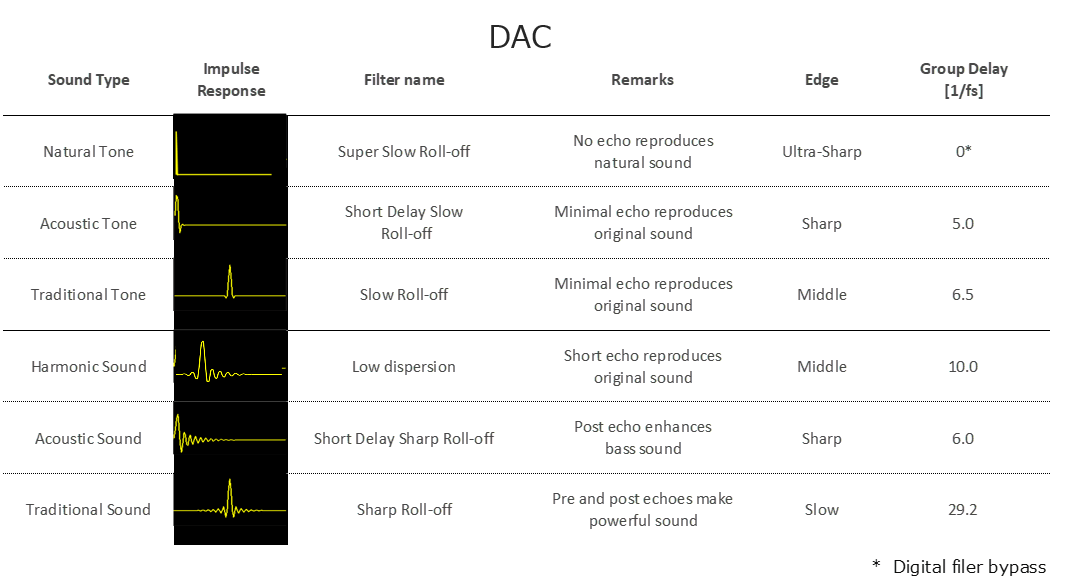 Figure 2. Digital filter (DAC)
Figure 2. Digital filter (DAC)
Next, we introduce AKM's latest approach to reducing the group delay of digital filters. A new concept is to separate the analogue and digital parts of DAC into separate ICs.
We propose the AK4498+AK4191. This concept is created with the utmost emphasis on sound quality. On the other hand, the possibility of digital processing, such as minimizing group delay in a system, is also greatly expanded. For example, analog ICs use the AK4498 and digital ICs use higher-performance DSP and FPGA to increase system-design flexibility and achieve even lower group delay. For details, refer to the news release.
2 - 2. Pursuing low delay for car infotainment market
Even in car infotainment, signal processing delays have many functions that affect performance. As an example, there is a 2-way in car communication system (Figure 3). In this system, the difference in time between the direct sound emitted from the talker and the sound played back during communication is a major factor that makes the discomfort of the call. Audio signals are processed by ADC / DSP / DAC between the mic inputs and the speaker outputs. In ADC / DAC, the time differences between the input and output signals appear as group delays, so minimizing group delays can contribute to minimizing system signal processing delays.
As you can see in the illustration, you need a lot of digital processing. Due to the real-time communication in a narrow space, 2-way in car communication leads to discomfort if many delays occur in these processes. To minimize the discomfort as much as possible, it is important to minimize the delay caused by arithmetic processing.
In digital signal processing as well, AKM has a rich lineup of DSP by taking advantage of its many years of experience in developing products. We propose optimal solutions for all passengers who ride in a car for comfortable interior spaces.
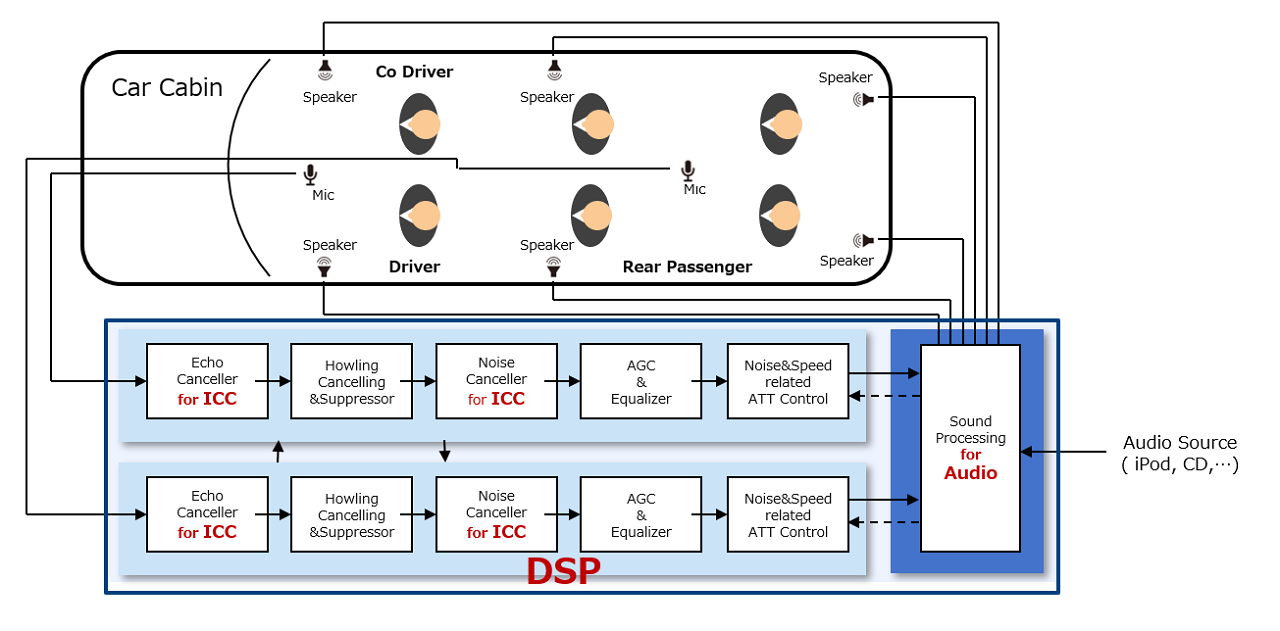 Figure 3. 2-way in car communication schematic diagram
Figure 3. 2-way in car communication schematic diagram
2 - 3. Proposal of advanced high-rate format aimed at high sound quality
In recent years, PCM and DSD have been widely used as audio formats, and in proportion to the speed-up of the network, the sampling rate is also required to accommodate a wide range.
Figure 4 shows CDs and the latest audio formats of PCM and DSD. The vertical axis in this figure is the number of bits in each audio format and the horizontal axis is the bit rate.
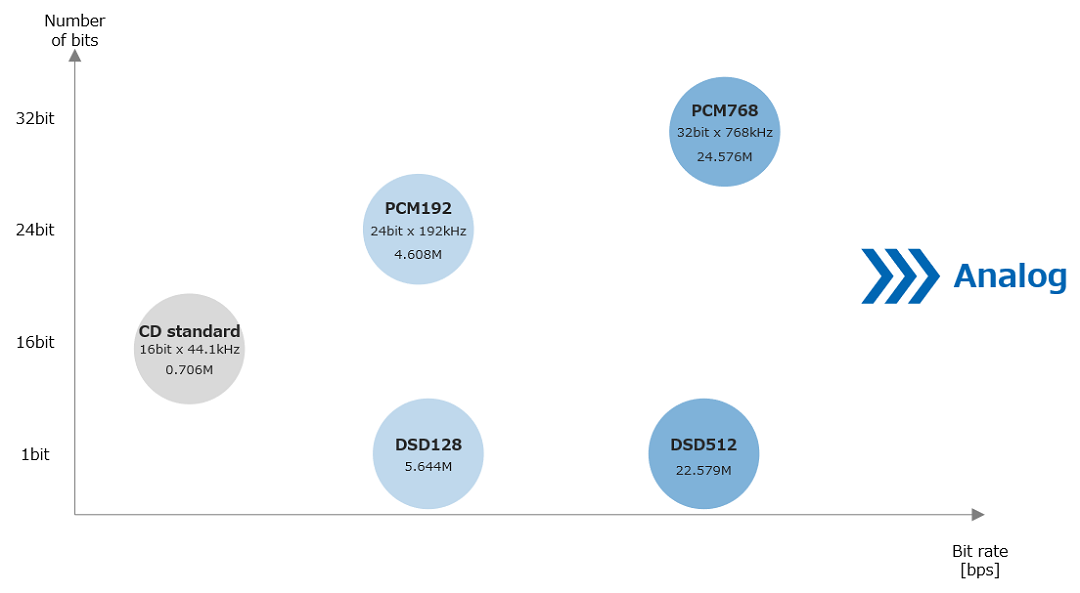 Figure 4. Changes in the amount of information in high-resolution audio
Figure 4. Changes in the amount of information in high-resolution audio
It is well known that PCM is multi-bit (16-32 bits) and DSD is 1-bit. These data have two parameters, data resolution (in bits) and data rate, which are difficult to understand in simple comparisons. In this example, the bit rate obtained by multiplying the number of bits in the audio format by the data rate is used as the horizontal axis to represent the amount of information in both data on an equal footing.
The bit rate increases as the horizontal axis in Figure 4 moves to the right. It can be seen that the bit rate increases as the high-resolution increases. In other words, it is equivalent to having an infinite amount of information. The progress of high resolution means that the sound source approaches the analog as much as possible, regardless of the type of audio format.
AKM has expanded its lineup of high-resolution products from products developed in 2000. Currently, DSD512 (22.579MHz) and PCM 768kHz/32-bit are the upper limits of high resolution due to physical limitations such as communication rate, storage medium capacity, and IC throughput.
Now it is impossible, but we don't know what will happen in 10 years. Studies have verified data-handling with 1-bit sampling on the order of GHz [1]. In the future, if the communication rate and IC throughput are improved, you will be able to enjoy higher-rate sound sources by streaming and other means. AKM will continue to develop technologies and products in anticipation of future high resolution.
3. Wide range of lineup for pure audio + portable, car, professional audio and distribution
In this chapter, we introduce ADC / DAC lineup described so far and the latest portable ICs and automotive ICs as well.
AKM provides a wide range of audio ICs for professional audio, consumer high-end equipment applications as well as for portable and automotive audio. In 2000, we launched our first 32-bit ADC / DAC. After that we also released some devises with sampling frequency up to 768kHz/DSD512 in anticipation of the possibility of future audio development. Currently, the latest product lineup is adopted by many customers in professional audio and consumer products as follows.
Lineup information is current as of July 2020.
Please check akm.com for product sales status updates.
Table 4. ADC lineups
| ADC P/N | Ch | Resolution [bit] |
S/N [dB] |
THD+N [dB] |
Max fs [kHz] |
DSD Input [MHz] |
Sound Color |
|---|---|---|---|---|---|---|---|
| AK5397EQ | 2 | 32 | 127 | -108 | 768 | - | 3 types |
| AK5572EN | 2 | 32 | 121 | -112 | 768 | 11.2 | 4 types |
| AK5574EN | 4 | 32 | 121 | -112 | 768 | 11.2 | 4 types |
| AK5576EN | 6 | 32 | 121 | -112 | 768 | 11.2 | 4 types |
| AK5578EN | 8 | 32 | 121 | -112 | 768 | 11.2 | 4 types |
| AK5552VN | 2 | 32 | 115 | -106 | 768 | 11.2 | 4 types |
| AK5554VN | 4 | 32 | 115 | -106 | 768 | 11.2 | 4 types |
| AK5556VN | 6 | 32 | 115 | -106 | 768 | 11.2 | 4 types |
| AK5558VN | 8 | 32 | 115 | -106 | 768 | 11.2 | 4 types |
Table 4. DAC lineups
| DAC P/N | Ch | Resolution [bit] |
S/N [dB] |
THD+N [dB] |
Max fs [kHz] |
DSD Input [MHz] |
Sound Color |
|---|---|---|---|---|---|---|---|
| AK4499EQ | 4 | 32 | 134 | -124 | 768 | 22.4 | 6 types |
| AK4497EQ | 2 | 32 | 128 | -116 | 768 | 22.4 | 6 types |
| AK4493EQ | 2 | 32 | 123 | -113 | 768 | 22.4 | 6 types |
| AK4490EQ | 2 | 32 | 120 | -112 | 768 | 11.2 | 5 types |
| AK4452VN | 2 | 32 | 115 | -107 | 768 | 11.2 | 5 types |
| AK4454VN | 4 | 32 | 115 | -107 | 768 | 11.2 | 5 types |
| AK4456VN | 6 | 32 | 115 | -107 | 768 | 11.2 | 5 types |
| AK4458VN | 8 | 32 | 115 | -107 | 768 | 11.2 | 5 types |
| AK4468VN | 8 | 32 | 117 | -107 | 768 | 22.4 | 5 types |
In addition, the latest portable ICs are the AK4332 mono DAC and AK4331 stereo DAC that have realized high sound quality and low power consumption by making use of our branded "VELVET SOUND technology."
As a 32-bit dedicated audio DSP supporting floating point arithmetic for car infotainment, we have begun supplying a successor AK7739 for the best-selling AK7738 that has been used in various in-vehicle head units for sound field processing of high-resolution sound sources and hands-free applications. This product delivers such a scene in which you listen to music in the cabin and make hands-free calls. It is also equipped with a DAC that uses VELVET SOUND technology.
We have also released 4-channel ADC AK5734 for microphones for use in active noise control systems (ANC*) and road noise control systems (RNC*), which are increasingly being installed in automobiles. This product integrates a diagnostic function monitoring for microphone connection status, which is indispensable for in-vehicle communication. The AK573x series offers a 20% reduction in group delay compared to conventional products, which improves usability. Furthermore their ultra-high input impedance of 1.48MΩ greatly extends the choice of ADC pre-amplifier.
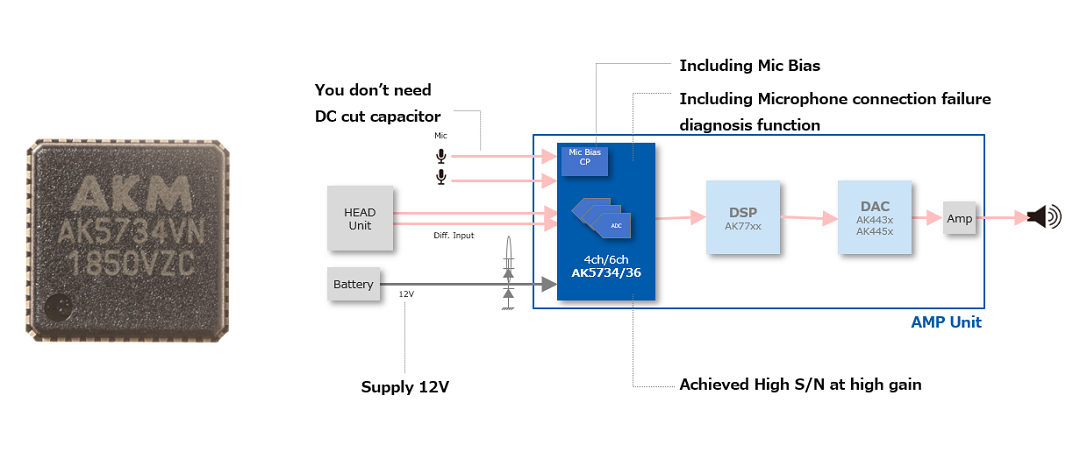 Figure 5. Example of AK5734’s microphone module application
Figure 5. Example of AK5734’s microphone module application
At the end of this chapter, we would like to consider a few things that AKM can do in developing the next new ICs in an environment where the impact of a new corona virus has increased the chance to stay at home.
As Web distribution is increasingly used at home, a demand for audio interfaces for YouTube distribution in music recordings is growing. It is sufficient to have PCs, smartphones, and tablets for delivery, but systems like audio interfaces are required to add BGM or deliver high quality sound. Figure 6 shows a schematic diagram of the system for such distribution.
AKM's ADC is adopted by many audio interface manufacturers. In the future, we hope to provide new value by further developing new movements such as live streaming and remote concert, and by improving the live sense of presence and unity so that more people can enjoy music.
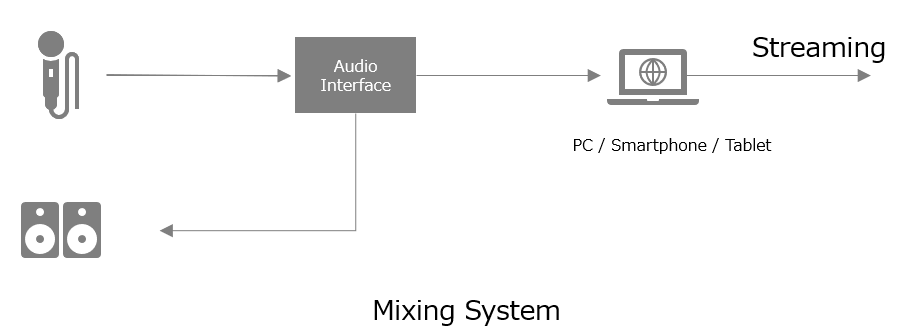 Figure 6. Live streaming distribution schematic diagram
Figure 6. Live streaming distribution schematic diagram
4. AKM's audio brand "VELVET SOUND”
In 2014, we renewed our audio technology and launched “VELVET SOUND” as an audio brand of AKM. We are the only semiconductor manufacturer to exhibit at "HIGH END" audio exhibition held in Munich, Germany in 2019.
We’re currently delivering a variety of information from VELVET SOUND brand Website, including audio meister videos, glossary related to audio ICs, customer stories, and an interview with Daishin Kashimoto, 1st Concertmaster of the Berlin Philharmonic, brand ambassador for VELVET SOUND. You can see it at the following
 Daishin Kashimoto
Daishin Kashimoto
Reference
[1] Takanori KANEMOTO, Yasuhito ISHIHARA, Otonobu YASOJIMA, Yasuhiro OIKAWA, Yoshio YAMAZAKI (Waseda University)
"Recent 1-bit Technology Applications" the 8th 1-bit Study Group (Dec.2013)
Author’s profile
Mitsuru ANIYA
1991 Master's course at Nagaoka University of Technology was completed and joined Asahi Kasei Corporation in the same year. After joining the company, he was involved in designing CMOS IC with a focus on ΔΣADC/ DAC for audio equipment for 23 years.
At present, He is engaged in the product development of audio ICs as a senior audio technology expert.
 Mr. Aniya (AKM)
Mr. Aniya (AKM)


